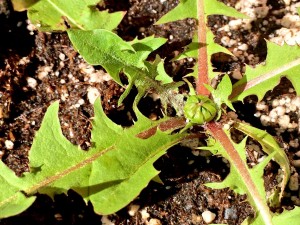Written by: Lynn M. Sosnoskie, Ph.D., WSU Weed Science
Despite the widespread adoption and use of herbicides, weeds still persist in agricultural and horticultural systems. Weeds can escape chemical control for numerous reasons, including: incorrect herbicide or rate selection, improper sprayer calibration, clogged nozzles or otherwise malfunctioning equipment, weed size (e.g. too large for control), herbicide applications that are made under less-than-ideal environmental conditions (e.g. too cold, too windy, too wet or too dry), and the development of herbicide resistance in weed species. The Weed Science Society of America (WSSA) defines herbicide resistance as “the inherited ability of a plant to survive and reproduce following exposure to a dose of herbicide that is normally lethal”. There are two general mechanisms of herbicide resistance. Target site resistance occurs when the enzyme that is the target of the herbicide becomes “insensitive” to the herbicide that was applied. The loss of sensitivity is usually associated with a mutation in the gene that codes for the enzyme that the herbicide adheres to in the plant. These mutations lead to physical changes in the enzyme’s shape/structure, which prevents herbicide-binding, thus reducing or eliminating herbicidal activity. Alternately, a mechanism of resistance may not be directly related to the herbicide target site; this type of occurrence is called non-target site resistance. Non-target site mechanisms can impede herbicide uptake, translocation, and accrual or else protect the plant against the actions of the herbicide (Delye 2013).
The first occurrences of herbicide resistance were noted in 1957 in populations of spreading dayflower (Commelina diffusa) and wild carrot (Daucus carota), both of which were described as being insensitive to 2, 4-D (Hilton 1957; Switzer 1957; Whitehead and Switzer 1963). The next recorded incidence of resistance occurred in 1970 when scientists reported the discovery of common groundsel (Senecio vulgaris) plants in a conifer nursery that were unable to be controlled by simazine (Radosevitch and Appleby 1973; Ryan 1970). Since these initial findings, the occurrence of herbicide-resistant weeds has increased, significantly. To date, more than 250 plant species, worldwide, have developed resistances to one or more herbicide sites of action (http://weedscience.org).
Across all crops, there are 12 unique cases (weed species x site of action) of herbicide resistance in Washington state (Table 1). There are 19 unique cases in Oregon, 11 in Idaho, 14 in Montana, 3 in Wyoming, and 30 in California (Heap 2017). Six instances of glyphosate (WSSA Group 9) resistance have been confirmed in tree and vine crops in California and Oregon: annual bluegrass (Poa annua), junglerice (Echinochloa colona), horseweed/marestail (Conyza canadensis), hairy fleabane (Conyza bonariensis), Italian ryegrass (Lolium perenne), and rigid ryegrass (Lolium rigidum). Multiple resistance to glyphosate and paraquat (WSSA Group 22) has been detected in horseweed/marestail and hairy fleabane in California. Multiple resistance to glyphosate and glufosinate (WSSA Group 10) has been detected in Italian ryegrass in Oregon. Italian ryegrass with resistance to three herbicide groups (WSSA 1, 9, and 22) and four herbicide groups (WSSA 1, 2, 9, and 22) has been reported in California.
Table 1. List of herbicide-resistant weeds in the state of Washington, year confirmed, and herbicide site of action (WSSA group). Data were obtained from http://weedscience.org.
| Year | Species | Site of Action |
| 1970 | Senecio vulgaris Common Groundsel | Photosystem II inhibitors (WSSA 5) |
| 1987 | Salsola tragus Russian-thistle | ALS inhibitors (WSSA 2) |
| 1988 | Centaurea solstitialis Yellow Starthistle | Synthetic Auxins (WSSA 4) |
| 1989 | Kochia scoparia Kochia | ALS inhibitors (WSSA 2) |
| 1991 | Avena fatua Wild Oat | ACCase inhibitors (WSSA 1) |
| 1992 | Amaranthus powellii Powell Amaranth | Photosystem II inhibitors (WSSA 5) |
| 1993 | Lactuca serriola Prickly Lettuce | ALS inhibitors (WSSA 2) |
| 2000 | Sonchus asper Spiny Sowthistle | ALS inhibitors (WSSA 2) |
| 2007 | Lactuca serriola Prickly Lettuce | Synthetic Auxins (WSSA 4) |
| 2010 | Amaranthus retroflexus Redroot Pigweed | Photosystem II inhibitors (WSSA 5) |
| 2010 | Chenopodium album Common Lambsquarters | Photosystem II inhibitors (WSSA 5) |
| 2010 | Anthemis cotula Mayweed Chamomile | ALS inhibitors (WSSA 2) |
Repeated use of a single product or herbicide group over space and time can lead to shifts in weed communities in which species tolerant or resistant to those products become dominant. Resistance prevention/mitigation efforts aim to interrupt the evolutionary process by reducing the selection pressure exerted through the use of herbicides. A logical first step in resistance management is to diversify the chemical products that are being used in a system. Although herbicide rotations and mixtures are important tools for combating the development of herbicide-resistance in weeds, chemical products cannot be used alone or indiscriminately so as to prevent additional resistances from developing. In a recent 2016 manuscript, Evans et al. reported that while “herbicide mixing could delay [the development of glyphosate resistance] or other [herbicide resistance] weed traits, they are unlikely to prevent them.” In other words, this strategy alone “may delay evolution of resistance, but do not prevent it.” In addition to diversifying herbicides, applicators need to ensure that all products are being applied according to label recommendations; weed control will be maximized (and escapes, minimized) when weeds are controlled at the proper growth stage, using the proper herbicide rate, at the proper time of the year.
Physical elimination via shallow cultivation, cutting, or mowing (provided the equipment is properly set to make sure roots or tree trunks are not damaged) can help to reduce the selection pressures associated with repeated herbicide use. It is important to note that physical control measures can also exert their own selection pressures on a system; for example, repeated mowing may drive the species composition towards weeds with a prostrate habit (Figure 1) (Abu-Dieyeh and Watson 2005). This suggests that non-chemical control measures should also be diversified, as much as possible, in order to avoid species tolerant of a given physical strategy. If herbicide resistance is suspected, field equipment should be cleaned to prevent spreading the tolerant biotype between orchards.

Careful observation and record-keeping can help growers evaluate successes (and failures) in their systems and allow for early detection and prevention of herbicide-resistant species. Actively scout and take careful notes about the density and distribution of weed species both within a growing season and across years. Record keeping allows us to evaluate herbicide performance and determine if weed-shifts are occurring due to chemical selection pressure. It is important to remember that weed management should extend beyond the crop in both time and space; weeds that emerge post-harvest or along orchard borders have the potential to reestablish or enhance the in-crop seedbank. Ideally, any escaped weeds should be prevented from reaching reproductive maturity.
Herbicides are one of the most effective strategies for controlling weeds, however they must be used judiciously. They should be ‘one of the many tools’ in a weed management toolbox rather than the only implement, or else we risk losing their efficacy due to the evolution of herbicide-resistant weeds. A list of Best Management Practices (BMPs) to reduce the risks of herbicide resistance can be found in a special issue of the journal Weed Science (Norseworthy et al. 2012). This article is open access (free to download) and can be obtained here.
Contact
 Lynn M. Sosnoskie, Ph.D.
Lynn M. Sosnoskie, Ph.D.
Assistant Research Faculty, Washington State University
Tree Fruit Research and Education Center
Wenatchee, WA 98801
Phone: 229-326-2676
@LynnSosnoskie on Twitter
Citations:
Abu-Dieyeh M. and A. Watson. 2005. Impact of mowing and weed control on broadleaf weed population dynamics in turf. J. Plant Interact. 1:239-252,
Delye, C. 2013. Unravelling the genetic bases of non‐target‐site‐based resistance (NTSR) to herbicides: a major challenge for weed science in the forthcoming decade. Pest Manage. Sci. 69:176-87.
Evans, J. A. et al. 2016.Managing the evolution of herbicide resistance. Pest. Manage. Sci. 72:74–80.
Hilton, H.W. 1957. Herbicide tolerant strains of weeds. Hawaiian Sugar Plant. Assoc. Annu. Rep. p 69.
Norseworthy et al. 2012. Reducing the risks of herbicide resistance: Best management practices and recommendations. Weed Sci. 60 (Sp1): 31-62.
Radosevitch, S.R. and A.P. Appleby. 1973. Relative susceptibility of two common groundsel (Senecio vulgaris L.) biotypes to 6 s-triazines. Agron. J. 65:553-555.
Ryan, G.F. 1970. Resistance of common groundsel to simazine and atrazine. Weed Sci. 18:614-616.
Switzer, C.M. 1957. The existence of 2, 4-D resistant strains of wild carrot. Proc. of the North Eastern Weed Control Conference. 11: 315-318.
Whitehead, C.W. and Switzer, C.M. 1963. The differential response of strains of wild carrot to 2, 4-D and related herbicides. Can. J. of Plant Sci. 43:255-262.
Fruit Matters articles may only be republished with prior author permission © Washington State University. Reprint articles with permission must include: Originally published by Washington State Tree Fruit Extension Fruit Matters at treefruit.wsu.edu and a link to the original article.